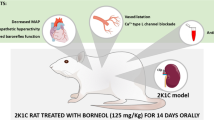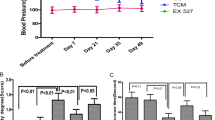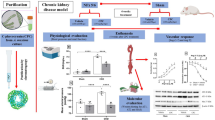Abstract
Aim:
To investigate the role of ATP-sensitive potassium (KATP) channels on blood pressure variability (BPV) in sinoaortic denervated (SAD) rats.
Methods:
SAD was performed on male Sprague-Dawley rats 4 weeks before the study. mRNA expression of Kir6.1, Kir6.2 and SUR2 in aorta and mesenteric artery was determined using real-time quantitative polymerase chain reaction, and confirmed at the protein level using Western blotting and laser confocal immunofluorescence assays. Concentration-response curves of isolated aortic and mesenteric arterial rings to adenosine and pinacidil were established. Effects of KATP channel openers and blocker on BPV were examined in conscious SAD rats.
Results:
Aortic SUR2 expression was significantly greater, while Kir6.1 was lower, in SAD rats than in sham-operated controls. In contrast, in the mesenteric artery both SUR2 and Kir6.1 expression were markedly lower in SAD rats than controls. For both arteries, Kir6.2 expression was indistinguishable between sham-operated and SAD rats. These findings were confirmed at the protein level. Responses of the aorta to both adenosine and pinacidil were enhanced after SAD, while the mesenteric response to adenosine was attenuated. Pinacidil, diazoxide, nicorandil, and glibenclamide significantly decreased BPV.
Conclusion:
These findings indicate that expression of vascular KATP channels is altered by chronic SAD. These alterations influence vascular reactivity, and may play a role in the increased BPV in chronic SAD rats.
Similar content being viewed by others
Log in or create a free account to read this content
Gain free access to this article, as well as selected content from this journal and more on nature.com
or
References
Krieger EM . Neurogenic hypertension in the rat. Circ Res 1964; 15: 511–21.
Norman RA Jr, Coleman TG, Dent AC . Continuous monitoring of arterial pressure indicates sinoaortic denervated rats are not hypertensive. Hypertension 1981; 3: 119–25.
Pires SL, Julien C, Chapuis B, Sassard J, Barres C . Spontaneous renal blood flow autoregulation curves in conscious sinoaortic baroreceptor-denervated rats. Am J Physiol Renal Physiol 2002; 282: F51–8.
Tatasciore A, Renda G, Zimarino M, Soccio M, Bilo G . Parati G, et al. Awake systolic blood pressure variability correlates with target-organ damage in hypertensive subjects. Hypertension 2007; 50: 325–32.
Rothwell PM . Limitations of the usual blood-pressure hypothesis and importance of variability, instability, and episodic hypertension. Lancet 2010; 375: 938–48.
Rothwell PM, Howard SC, Dolan E, O'Brien E, Dobson JE, Dahlof B, et al. Effects of beta blockers and calcium-channel blockers on within-individual variability in blood pressure and risk of stroke. Lancet Neurol 2010; 9: 469–80.
Webb AJ, Fischer U, Mehta Z, Rothwell PM . Effects of antihypertensive-drug class on interindividual variation in blood pressure and risk of stroke: a systematic review and meta-analysis. Lancet 2010; 375: 906–15.
Alper RH, Jacob HJ, Brody MJ . Regulation of arterial pressure lability in rats with chronic sinoaortic deafferentation. Am J Physiol 1987; 253: H466–74.
Trapani AJ, Barron KW, Brody MJ . Analysis of hemodynamic variability after sinoaortic denervation in the conscious rat. Am J Physiol 1986; 251: R1163–9.
Jacob HJ, Alper RH, Brody MJ . Lability of arterial pressure after baroreceptor denervation is not pressure dependent. Hypertension 1989; 14: 501–10.
Jacob HJ, Alper RH, Grosskreutz CL, Lewis SJ, Brody MJ . Vascular tone influences arterial pressure lability after sinoaortic deafferentation. Am J Physiol 1991; 260: R359–67.
Shen FM, Su DF . The effect of adenosine on blood pressure variability in sinoaortic denervated rats is mediated by adenosine A2a-receptor. J Cardiovasc Pharmacol 2000; 36: 681–6.
Pires SL, Barres C, Sassard J, Julien C . Renal blood flow dynamics and arterial pressure lability in the conscious rat. Hypertension 2001; 38: 147–52.
Stauss HM, Petitto CE, Rotella DL, Wong BJ, Sheriff DD . Very low frequency blood pressure variability is modulated by myogenic vascular function and is reduced in stroke-prone rats. J Hypertens 2008; 26: 1127–37.
Quayle JM, Nelson MT, Standen NB . ATP-sensitive and inwardly rectifying potassium channels in smooth muscle. Physiol Rev 1997; 77: 1165–232.
Tan JH, Al Abed A, Brock JA . Inhibition of KATP channels in the rat tail artery by neurally released noradrenaline acting on postjunctional alpha2-adrenoceptors. J Physiol 2007; 581: 757–65.
Yasui S, Mawatari K, Kawano T, Morizumi R, Hamamoto A, Furukawa H, et al. Insulin activates ATP-sensitive potassium channels via phosphatidylinositol 3-kinase in cultured vascular smooth muscle cells. J Vasc Res 2008; 45: 233–43.
Eguchi S, Kawano T, Yinhua, Tanaka K, Yasui S, Mawatari K, et al. Effects of prostaglandin E1 on vascular ATP-sensitive potassium channels. J Cardiovasc Pharmacol 2007; 50: 686–91.
Shi W, Cui N, Shi Y, Zhang X, Yang Y, Jiang C . Arginine vasopressin inhibits Kir6.1/SUR2B channel and constricts the mesenteric artery via V1a receptor and protein kinase C. Am J Physiol Regul Integr Comp Physiol 2007; 293: R191–9.
Bryan PT, Marshall JM . Cellular mechanisms by which adenosine induces vasodilatation in rat skeletal muscle: significance for systemic hypoxia. J Physiol 1999; 514: 163–75.
Nichols CG . KATP channels as molecular sensors of cellular metabolism. Nature 2006; 440: 470–6.
Colantuono G, Tiravanti EA, Di Venosa N, Cazzato A, Rastaldo R, Cagiano R, et al. Hyperoxia confers myocardial protection in mechanically ventilated rats through the generation of free radicals and opening of mitochondrial ATP-sensitive potassium channels. Clin Exp Pharmacol Physiol 2008; 35: 64–71.
Miao CY, Su DF . The importance of blood pressure variability in rat aortic and left ventricular hypertrophy produced by sinoaortic denervation. J Hypertens 2002; 20: 1865–72.
Li L, Wu J, Jiang C . Differential expression of Kir6.1 and SUR2B mRNAs in the vasculature of various tissues in rats. J Membr Biol 2003; 196: 61–9.
Shi Y, Cui N, Shi W, Jiang C . A short motif in Kir6.1 consisting of four phosphorylation repeats underlies the vascular KATP channel inhibition by protein kinase C. J Biol Chem 2008; 283: 2488–94.
Suzuki M, Li RA, Miki T, Uemura H, Sakamoto N, Ohmoto-Sekine Y, et al. Functional roles of cardiac and vascular ATP-sensitive potassium channels clarified by Kir6.2-knockout mice. Circ Res 2001; 88: 570–7.
Chutkow WA, Pu J, Wheeler MT, Wada T, Makielski JC, Burant CF, et al. Episodic coronary artery vasospasm and hypertension develop in the absence of Sur2 KATP channels. J Clin Invest 2002; 110: 203–8.
Miura H, Wachtel RE, Loberiza FR Jr, Saito T, Miura M, Nicolosi AC, et al. Diabetes mellitus impairs vasodilation to hypoxia in human coronary arterioles: reduced activity of ATP-sensitive potassium channels. Circ Res 2003; 92: 151–8.
Fan LH, Tian HY, Ma AQ, Hu Z, Huo JH, Cao YX . Altered ATP-sensitive potassium channels may underscore obesity-triggered increase in blood pressure. Acta Pharmacol Sin 2008; 29: 1167–74.
Akao M, Otani H, Horie M, Takano M, Kuniyasu A, Nakayama H, et al. Myocardial ischemia induces differential regulation of KATP channel gene expression in rat hearts. J Clin Invest 1997; 100: 3053–9.
Ghosh M, Hanna ST, Wang R, McNeill JR . Altered vascular reactivity and KATP channel currents in vascular smooth muscle cells from deoxycorticosterone acetate (DOCA)-salt hypertensive rats. J Cardiovasc Pharmacol 2004; 44: 525–31.
Shimokawa J, Yokoshiki H, Tsutsui H . Impaired activation of ATP-sensitive K+ channels in endocardial myocytes from left ventricular hypertrophy. Am J Physiol Heart Circ Physiol 2007; 293: H3643–9.
Julien C, Zhang ZQ, Barres C . Role of vasoconstrictor tone in arterial pressure lability after chronic sympathectomy and sinoaortic denervation in rats. J Auton Nerv Syst 1993; 42: 1–10.
Farzaneh T, Tinker A . Differences in the mechanism of metabolic regulation of ATP-sensitive K+ channels containing Kir6.1 and Kir6.2 subunits. Cardiovasc Res 2008; 79: 621–31.
Wu MY, Ma XJ, Yang C, Tao X, Liu AJ, Su DF, et al. Effects of allisartan, a new AT1 receptor blocker, on blood pressure and end-organ damage in hypertensive animals. Acta Pharmacol Sin 2009; 30: 307–13.
Wang JL, Wang L, Wu ZT, Yuan WJ, Su DF, Ni X, et al. Low dose of moxonidine within the rostral ventrolateral medulla improves the baroreflex sensitivity control of sympathetic activity in hypertensive rat. Acta Pharmacol Sin 2009; 30: 1594–600.
Acknowledgements
This work was supported in part by the grants from National Natural Science Foundation of China (81070118), Shanghai Municipal Education Commission (10ZZ52), and the National Basic Research Program of China (2009CB521900).
Author information
Authors and Affiliations
Corresponding author
Rights and permissions
About this article
Cite this article
Yang, Zw., Li, Dj., Liu, C. et al. Role of vascular KATP channels in blood pressure variability after sinoaortic denervation in rats. Acta Pharmacol Sin 32, 194–200 (2011). https://doi.org/10.1038/aps.2010.195
Received:
Accepted:
Published:
Issue date:
DOI: https://doi.org/10.1038/aps.2010.195
Keywords
This article is cited by
-
The baroreflex afferent pathway plays a critical role in H2S-mediated autonomic control of blood pressure regulation under physiological and hypertensive conditions
Acta Pharmacologica Sinica (2021)
-
TRPC6 participates in the development of blood pressure variability increase in sino-aortic denervated rats
Heart and Vessels (2020)
-
Metformin improves the angiogenic functions of endothelial progenitor cells via activating AMPK/eNOS pathway in diabetic mice
Cardiovascular Diabetology (2016)



